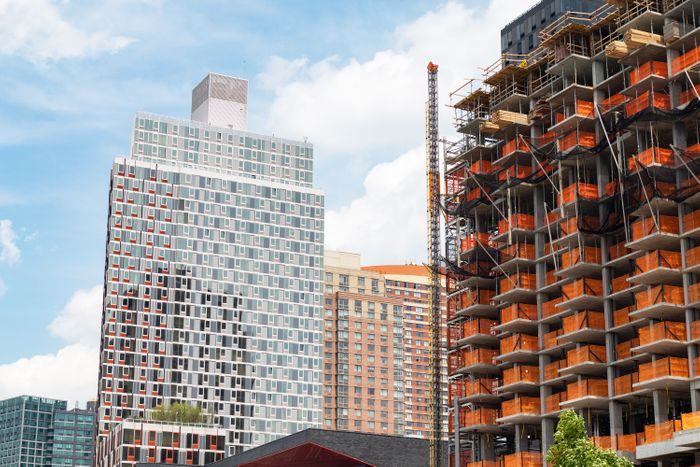
Why does anyone live in Long Island City? Despite its charms (MoMA PS1, the Noguchi Museum, Gantry State Park, Manducatis), the answer most residents give is some variation on “efficiency.” It’s a neighborhood of mostly new buildings that are clean and functional and lavishly amenitized, and less expensive than living just across the river. Most of all, it’s a super-quick commute to Manhattan.
Which meant that last year, when the pandemic hit and those commutes ended, so did the chief draw of Long Island City. Office workers were leaving the city in droves, a quick ride into Manhattan wasn’t on anyone’s wish list, and the apartments, though larger than those in Manhattan, were not spacious enough to be comfortable work-at-home environments. Landlords were not quite giving away leases, but it came close, at least by New York standards: The incentives being offered in the neighborhood were “a little overwhelming for a while,” admitted Zoe Elghanayan, a principal and senior vice-president at TF Cornerstone, which owns and operates seven high-rise rentals in Long Island City. “The standard was three to four months free,” she said. “That’s not how we like to do things. It was unprecedented — how long the incentives lasted, and how many months were offered.”
Now the rebound has hit, and Long Island City rents are sharply on the rise. They’re up 5.82 percent in May over April, according to the brokerage firm MNS, a figure that likely indicates that workers who left during the pandemic are returning to the city. (That is roughly triple the citywide increase: Queens rents overall were up 1.73 percent and Manhattan rents by 1.54 percent.) Elghanayan’s firm has dropped back the incentives from three months’ free rent to one. “There’s a mass migration of people coming back into the city, and many are choosing to go to Long Island City,” said Mark Metzger, a real-estate agent at Bond New York. In May, the average L.I.C. rental price was $3,204 before concessions were factored in, an increase of 10.67 percent from the January low of $2,895, when concessions were also more generous, according to MNS. Two-bedroom rentals were a big driver of that jump, probably because people are anticipating a hybrid schedule that will involve working from home several days a week.
Early on in the pandemic, Long Island City seemed to be doing okay, according to Andrew Barrocas, the chief executive of MNS. “In June and July people were still thinking they’d be back in their offices or schools by Labor Day,” he said. But when it became obvious that wasn’t going to happen, people cleared out, rents dropped, and concessions got crazy. Barrocas said that he’d heard of five months free being offered and vacancy rates spiking to 50 percent at some of the larger buildings. “That’s essentially another lease up.” Some others left the city altogether. Jonathan Wheeler, a 29-year-old accountant, had moved to Long Island City in 2015, and when the shutdown hit, he and his girlfriend “were both working from home in a one-bedroom. It wasn’t a lot of space,” he said. They moved to Albany when their lease came up for renewal last September. “The market in Long Island City consists of two big groups: employees working in the Midtown East Corridor and international students,” Barrocas explained. “These were people who had the ability to leave, and they left.”
As in other areas of the city, a feverish sales market preceded the rental recovery, according to Patrick W. Smith, an associate broker at Corcoran. In the first quarter of 2021, the Long Island City market averaged 15 contracts per week, more than even the ten-contract-a-week flurry during the height of Amazon speculation. “Since I started tracking the market in 2006, we’ve never been busier,” said Smith, adding that the lines at Sweetleaf Coffee, which vanished during the pandemic, have returned.
By the end of this September, 62 percent of employees are expected to return to their offices, according to a recent survey released by the Partnership for New York City. And though just 12 percent had returned as of late May, renters seem eager to take advantage of the lingering pandemic deals and the city’s burgeoning post-vaccine social life before they troop back to the office in September.
Although Long Island City may lack the appeal of a Williamsburg or a Greenpoint, Metzger notes that it’s less expensive than Williamsburg and Greenpoint and the apartments are larger. “Also, a lot of buildings have washers and dryers built into the units. They’re brand-new buildings so they have the plumbing to support that. Manhattan buildings are older and they don’t.” Nearly everyone I spoke to for this story was also excited about the imminent opening of a Trader Joe’s.
Molly Socha, 34, a podcast producer, moved there this spring. She’d lived in Harlem for a number of years and thought of herself as “ride or die Manhattan,” but last June, her roommate was itching to get out of the city, so they rented an apartment in West New York, New Jersey. By this spring, she was longing to return, and after looking throughout Manhattan, Brooklyn, and Queens, she decided that “Long Island City felt so centrally located for seeing friends,” she said. And, yes, she cited the Manhattan commute, noting that she’s been able to join a softball league in Central Park. “We’re not fully back in the office yet, but when the time comes, I can take the ferry to Midtown.” Michelle Abrams, a 27-year-old commercial real estate broker who was living in Williamsburg before moving into a $3,025-a-month one-bedroom with an office at the recently-opened 5 Pointz development also cited the neighborhood’s “convenience to other places: It’s much faster for me to get to the Upper East Side for work.” And Wheeler and his girlfriend are back from Albany: They just signed a lease for a two-bedroom in their old building, so they’ll have an extra room to work from on the days they don’t go into the office. The rent, at about $5,000 a month, is hardly a steal, but it is, as ever, cheaper than it would be in Manhattan. And, as everyone rushes to say, it’s close.





